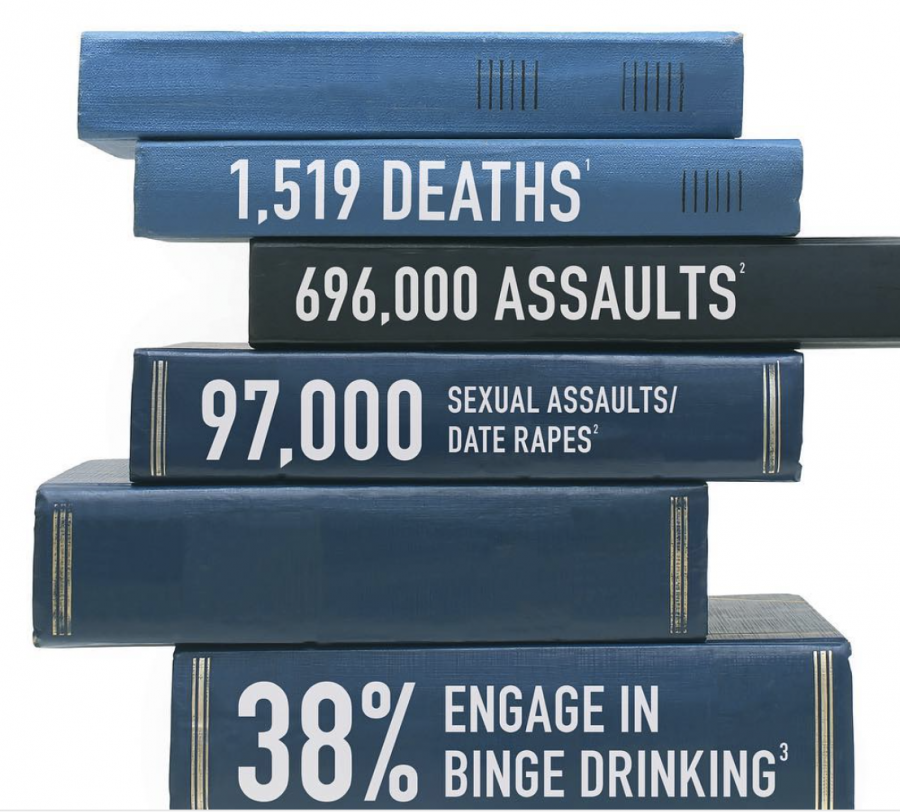Casual college drinker or borderline alcoholic? How the college experience influences alcohol abuse
October 2, 2018
It is a Saturday night in Champaign, Ill. Students at the University of Illinois have come up with a brilliant idea. Slurring their words and struggling to keep their balance, they circle a lone tree stump. It is the center for the next big drinking game on campus, rightfully called “Stump.” The goal is simple. You take a hammer, toss it up, catch the handle mid-air and hammer a nail into the stump, all in one swift motion. If you drop the hammer, you drink. If the nail gets completely pressed in, you lose. And then you drink again.
In 2015, the Princeton Review ranked the U of I one of the largest party schools in the nation. But the school is just one example of the collegiate drinking phenomenon.
College and binge-drinking go hand-in-hand. It is nothing more than a little fun to relieve the stress of being a college student. According to Michael Spell, a junior at Illinois State University, drinking is just part of the college experience.
“Some people say, ‘the weekend starts on Wednesday’ at ISU,” said Spell. “There are people walking around [on campus] from place to place all night, and you can tell they are looking for parties.”
Imagining herds of drunk college kids wandering the night searching for their party is uncomfortable, but not surprising.
About 40 percent of modern college students fit the medical diagnosis for Alcohol Use Disorder under the definition given by the latest Diagnostic and Statistical Manual of Mental Disorders used by mental health professionals.
In past editions of the DSM, addiction fell in two categories: substance abuse and substance dependence. Under the new edition, there is one diagnosis for both abuse and dependence, which is Alcohol Use Disorder. The diagnosis can be mild, moderate or severe. Under the old diagnosis, about 31 percent of students met criteria for alcohol abuse, with about 6 percent reaching dependent status.
“Alcohol is a drug that has a complex effect on the body,” said Richard Voss, a psychology professor at the College of DuPage. “It acts as a central nervous system depressant. It also lessens anxiety in a way that decreases inhibitions. A little of that can help people relax and be more social, but too much can contribute to the behavioral excesses and dangerous behavior we associate with alcohol abuse.”
Alcohol abuse on college campuses can be directly linked to binge drinking, the consumption of large amounts of alcohol in short periods of time. The Centers for Disease and Control Prevention states that one in six adults binge drinks around four times a month, with each binge consisting of an average of seven alcoholic drinks. Six people die every day from alcohol poisoning.
While it can be tricky to pinpoint which students are dependent on alcohol and which use it to relieve stress, the social climate surrounding partying can become unhealthy. From hazing, parties and drinking games like “Stump,” the mindless alcohol consumption can have lasting, deadly consequences.
“Alcohol is admittedly used as sort of a coping tool for stress,” said Jason Hackiewicz, a junior at the University of Illinois. “There are [students] who are legitimate alcoholics though, and it is maybe one of the most heartbreaking things to watch.”
Much of the drinking can be attributed to stress and peer pressure. Peer pressure as an emerging adult is complex. It is now manifested in societal expectations, even if they are inherently negative. The more someone is surrounded by it, the more likely it is that they will partake and go overboard, said Hackiewicz.
“I think that it is kind of a social norms thing,” said Hackiewicz. “It can be a bit difficult to tell people to cut back on [drinking] when it clearly looks like they have an issue, because you don’t want to seem like a buzzkill.”
Other college students feel the issue is not drinking but how people handle themselves and their responsibilities in general. “I know tons of people who party four days in a row and still have an almost perfect GPA, and I know people who never party who do not do well in school at all,” said Spell.
Mental health professionals and psychologists feel there is less emphasis on peer pressure and more placed on the expectations of transitioning to adulthood.
“They are facing many of the pressures and expectations of adulthood, and are asked to make important decisions regarding their lives and their future,” said Voss. “Add to this the financial pressure that may make working a part- or even full-time job necessary, and it’s hardly surprising students sometimes feel overwhelmed.”
Whether it is a personal or social problem, college drinking still has adverse community effects. The National Institute on Alcohol Abuse and Alcoholism states around 1,825 college students die from alcohol-related injuries, mainly in car accidents per year. Another 696,000 students experience an assault with someone who has been drinking. About 97,000 students reported being sexually assaulted by someone intoxicated.
Colleges often combat the drinking problem without much luck. Many schools try creative ways to curb alcohol consumption, including offering bartending classes, awarding perks to designated drivers and even giving students grants for their parties to purchase non-alcohol related items, according to TIME.
While doing these things may encourage safer drinking habits, Voss said it fails to address the underlying issues.
“There are no simple solutions, but I do think it’s important for colleges to do what they can to educate students about the dangers inherent in alcohol and drug use, as well as the many healthier coping strategies that are available,” said Voss.
Voss suggests going back to the basics with increased mental health counseling, stress management workshops and teaching students about the real dangers of binge-drinking are realistic ways of addressing the issue. There is likely no way to stop the partying, but teaching students there are other ways of coping with the stress of being a student will hold the most weight.
It is hard to tell which students will grow out of their “party” phase and go on to live normal lives, but it is important to treat every individual equally to ensure their safety and well-being are not affected by the potential dangers of alcohol abuse.


















